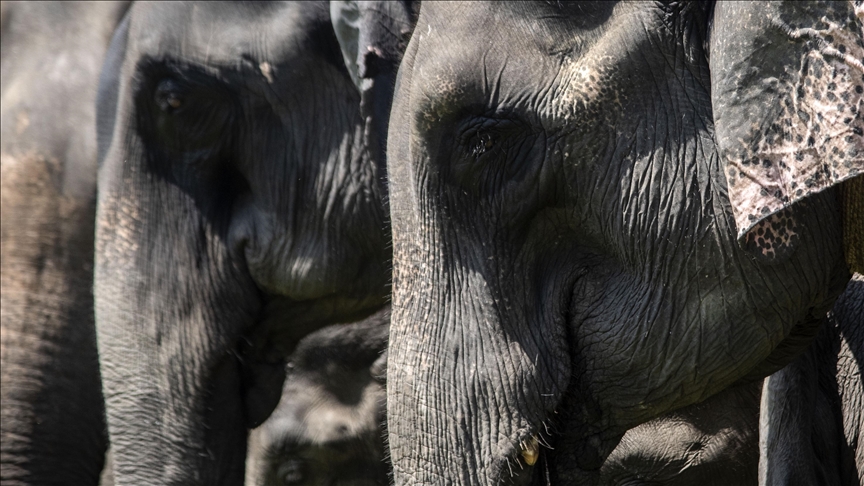Vanishing giants: Can Asia’s elephants survive as their world disappears?
As forests shrink and conflicts rise, conservationists race to protect the last 50,000 of the species
 Manas National Park in Baksa, India.
Manas National Park in Baksa, India.
- As forests shrink and conflicts rise, conservationists race to protect the last 50,000 of the species
- Populations have declined by more than 50% in the past three generations, and the largest land mammals in Asia now occupy just 15% of their historical range
- Experts stress the need for coordinated measures to protect a ‘keystone species’ whose presence shapes ecosystems and supports countless others
ISTANBUL
Once dominant in the vast forests they roamed freely, Asian elephants now walk a narrowing path as their habitat disappears and conflict with humans intensifies.
“We believe the current estimate is around 50,000 – less than 50,000 individuals left in the wild,” Nilanga Jayasinghe, WWF Network’s Lead for Asian Elephants, told Anadolu. “Numbers are pretty low, and we need to do a lot more to ensure their survival and conservation.”
Renowned for their intelligence and emotional depth, Asian elephants are listed as endangered on the International Union for Conservation of Nature (IUCN) Red List of Threatened Species – one step away from being critically endangered and two steps away from extinction.
Populations have declined by more than 50% in the past three generations, and the largest land mammals in Asia now occupy just 15% of their historical range.
Spread across 13 countries, Asian elephants are most at risk in Southeast Asia, where habitat loss, human-wildlife conflict, and poaching are accelerating their decline. From the dense forests of India to the fragmented habitats of Cambodia, experts warn that their numbers are vanishing faster than ever.
What’s driving the decline?
The primary cause of declining Asian elephant populations is the rapid loss and fragmentation of habitat.
“Asia is the most populated continent on the planet,” Jayasinghe said. “So, you can imagine that there is a lot of competition for space and resources.”
Elephants need vast home ranges to roam, forage and breed, yet forests are being divided by roads, railways, plantations and urban expansion.
“They can’t move through their habitats in a connected way,” she said, noting that this restricts access to food and water, and increases encounters with humans.
Fragmented landscapes also heighten the risk of vehicle and train collisions, often fatal for both people and elephants.
As elephants lose habitat, they wander into farmlands and villages – often with deadly consequences.
“Elephants may come into human-inhabited areas, might consume crops, destroy property, and sometimes even cause injury and death,” Jayasinghe said. “In return, people could retaliate and kill elephants.”
India, home to nearly 60% of the world’s Asian elephants, faces the greatest number of these encounters.
“(India) may be having a larger population, but this population of 29,000 exists in how many fragments?” said P.S. Easa, a member of the IUCN’s Asian Elephant Specialist Group.
Easa noted that key elephant habitats in southern India, the northeast, and the Himalayan foothills frequently overlap with human settlements. Wherever this happens, competition for water, land and crops leads to tension.
“The moment you have so much disturbance within (elephant ranges), you have to expect that definitely interaction is going to be negative,” he said.
According to the International Fund for Animal Welfare, 100 to 200 people die annually in India and Sri Lanka due to elephant encounters, often prompting retaliation that harms local populations.
In terms of poaching, Asian elephants are less targeted for ivory than their African counterparts, but the issue remains a serious concern.
Only some males grow tusks, but their selective hunting has caused a steady decline in tusked populations.
Illegal trade has expanded to include elephant skin, meat and other body parts in Southeast Asia. Calves are also captured for tourism.
Although India, Vietnam and Myanmar have banned wild elephant capture, wild elephants in Myanmar are still taken to labor in the timber industry and for illegal trafficking, prompting calls for stronger protection and sustainable captive management.
Keystone of the forest
Beyond their cultural importance, Asian elephants are keystone species – their presence shapes ecosystems and supports countless others.
“Elephants can be a really good umbrella species. By meeting their conservation needs, you are at the same time meeting the conservation needs of so many other species that are also threatened in the country,” said Pablo Sinovas, director of conservation charity Fauna & Flora in Cambodia.
From dispersing seeds to maintaining forest clearings, elephants sustain ecological balance, and entire ecosystems suffer when they disappear.
Jayasinghe described them as “intelligent, wise, empathetic and family-oriented,” emphasizing their role as “ecosystem engineers.”
Their movements create pathways for other animals, and even their footprints form small water-filled ponds that host aquatic life.
“They’re called a flagship species,” said Jayasingh. “If you’re conserving a space for them, you’re also helping the many other species that live with them in that same habitat, which is why it’s important that we conserve this amazing animal for generations to come.”
A coordinated path forward
Despite the challenges, experts see glimmers of hope.
Recent surveys in Cambodia’s northern forests revealed larger-than-expected elephant populations with healthy genetic diversity.
“That means there is potential for them to recover,” said Sinovas. “What we need is to make sure that landscape-level considerations are really prioritized … that human pressure is minimized … and that fragmentation is avoided when possible.”
Across Asia, governments are working with non-governmental organizations (NGOs) to implement action plans. India has led several efforts, particularly to identify and protect wildlife corridors.
“We had taken an initiative to identify the elephant corridors and connectivity issues between habitats,” said Easa, citing the Right of Passage report by Wildlife Trust of India as a major milestone, which was later expanded by government-led efforts.
NGOs in India also assist with rescues, medical care for injured elephants and public awareness, though their role depends on state-level cooperation, he said.
Easa highlighted the importance of regional collaboration through the Asian Elephant Specialist Group, which includes experts from India, Cambodia, Malaysia, Indonesia and Nepal.
Cambodia’s 10-year Asian Elephant Conservation Action Plan also outlines population recovery and habitat protection goals.
“The action plan is really a roadmap – and one of the challenges to implementation is funding,” said Sinovas. “It has been difficult to get funding for Asian elephants in Cambodia.”
Still, the existence of a coordinated strategy signals political will.
“It shows some coordination within the country, and that’s really important,” he added.
Can we make space for the wild?
The fate of Asian elephants is more than a conservation issue, as it reflects the bigger question of whether humanity can share land with wildlife in an increasingly developed world.
Saving the elephants, as experts stress, may also mean saving the forests – and the future – of an entire continent.
Jayasinghe said awareness, ethical tourism and responsible behavior, such as not feeding or disturbing wild elephants, are vital to their survival.
Yet, the pressures are mounting, and ultimately, conservationists say their survival depends not only on conservation efforts but also on a collective commitment to coexistence – so these majestic creatures can continue to roam the forests of Asia for generations to come.
Anadolu Agency website contains only a portion of the news stories offered to subscribers in the AA News Broadcasting System (HAS), and in summarized form. Please contact us for subscription options.







